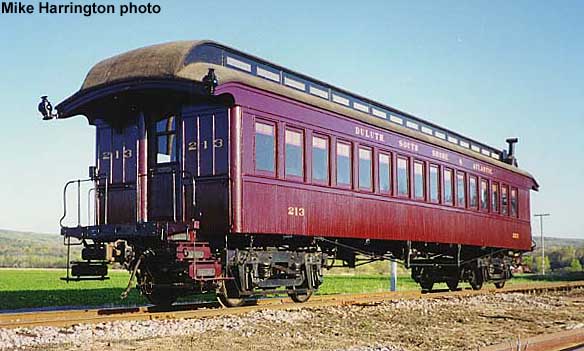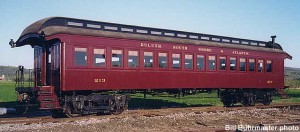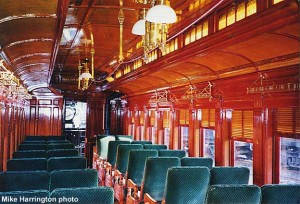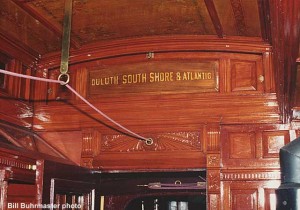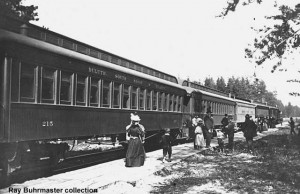First-Class Coach, Jackson & Sharp Co., Shop Order #2767, June 1888
Coach #213 was part of an order for twenty cars, numbered 210-229, built in 1888 for the Duluth South Shore & Atlantic Railway. These cars were of a standard open platform design that car builders had offered to the railroads for some twenty years. The cars served the DSS&A for many years as first class accommodations. When the vestibule-equipped cars arrived, the open-platform cars were used on secondary trains.
By the mid-1930’s the cars were no longer needed as revenue cars and the #213 was remodeled into a dining and kitchen car for work train crews. At this time the #213 was renumbered to #990. The #990 served the DSS&A and its subsequent owner, the Soo Line, as the bridge repair gang’s dining room until a 1969 switching accident rendered the car unfit for further service. An interesting side note on the durability and the care taken of these cars is that as of 2000 (112 years after they were built) four of the original order of twenty cars still survive.
The #213 was acquired by Mid-Continent in November 1969 and moved on a flat car to the museum’s North Freedom location. Restoration of the car to its 1910 appearance was deemed feasible and accomplished by Mid-Continent members. Of special note is the stenciling on the ceiling and the name “Duluth South Shore & Atlantic Ry.” above the end doors. This is the original stenciling that was uncovered during the removal of up to seven layers of paint. The car today is kept on display inside Coach Shed #1.
The #213 and its sister cars were a standard design open platform coach, an “off the shelf model,” and provide a look at the architecture adopted by the Jackson and Sharp Co. at the time. Of special note is the graceful reverse curve on the letter board at the platform hood. The interior of the car is trimmed in mahogany with end door entabler and window pilaster carvings. All the interior was varnished and the ceilings were stenciled. Lighting was by two-burner kerosene ceiling chandeliers and heat was provided by direct steam from the locomotive. A coal stove for emergency use was also provided. The seats were of the walkover design upholstered in plush and manufactured by the Hale & Kilburn Mfg. Co.
The Duluth South Shore & Atlantic Railway was formed in 1886 through the merger of several smaller railroads. The mainline of the railroad extended from Duluth to Sault Ste. Marie with a branch line extending into the Keweenaw peninsula. Control of the railroad soon passed into the hands of the Canadian Pacific Railroad and much of the traffic was directed to the CP at the Sault Ste. Marie gateway. On January 1, 1961, the DSS&A ceased to exist when it was officially merged into the newly organized Soo Line Railroad.
The Jackson & Sharp Co., known as the Delaware Car Works in advertisements, was founded in 1863. The firm built all types of railroad cars. In 1875 the firm diversified and acquired a shipbuilding company. In addition to shipbuilding, the company built sash and other millwork for buildings. In 1901 the plant came under the control of American Car and Foundry and ten years later was acquired by them. Under this American Car and Foundry ownership, the plant became the favored for construction of equipment for export due to its location on the water. During WW II the plant did work for the U.S. Navy. The plant was closed soon after WWII ended.

